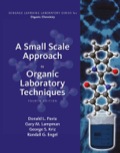
Interpretation:
The reason for the low mobility of chlorophylls on column chromatography is to be determined.
Concept introduction:
Column chromatography is a technique in
Answer to Problem 1Q
Chlorophylls are polar compounds. Therefore, chlorophylls tend to attach with the silica in the column which are also polar. Carotene are less polar compounds which easily elute through the column.
Explanation of Solution
In column chromatography, a long column is used that is packed with a polar compound such as silica or alumina. This compound acts as the stationary phase of the process.Silica (or alumina) is a polar compound. Usually, polar compound interact with other polar compounds due to attractions between them. When sample is passed which contains both silica and alumina through this column, chlorophyll tends to retain in the column while carotene elutes first. This is mainly because chlorophyll is a polar compound that retains in the column. Carotene is a less polar compound that elutes from the column.
The
Chlorophyll is a polar compound while carotene is a less polar compound. In the presence of a polar stationary phase, chlorophyll moves slower than carotene because chlorophyll attracts to the polar stationary phase.
Want to see more full solutions like this?
Chapter 15 Solutions
EBK A SMALL SCALE APPROACH TO ORGANIC L
- Upon screening with TLC (made of silica gel) chromatography using hexane/chloroform (3:1) as eluting solution, 3 spots were detected corresponding to a (A) polyphenol, a (B) tannin and an (C) alkaloid. Write the letters of your answers on the spots in the chromatogram shown at the right.arrow_forwardWhy chromatography is an important tool for analysis of organic compounds?arrow_forwardWhich one of the following chromatographic techniques is useful in the identification of organic molecules having molecular weights more than 20,000? 1) reverse phase chromatography 2) normal phase chromatography 3) high pressure liquid chromatography 4) gel permeation chromatographyarrow_forward
- A student performed a chromatography experiment to determine the Rf value of an unknown amino acid. The distances traveled by the amino acid and the solvent line were 3.0 cm and 8.5 cm, respectively. What is the Rf value for this amino acid? 0.3 cm O 0.35 1.8 5.5 0.85 cm 0.65 O 2.8arrow_forward1,8-Cineole is a predominant terpene found in cranberries. The concentration of 1,8-cineole in cranberries was determined using gas chromatography. A 5.00 g sample of freeze-dried cranberry powder was added to 10.0 mL water to form a cranberry extract. The extract was filtered. A 1.00 mL aliquot was added to a 25 ml volumetric along with a known amount of internal standard (d-14 cymene) and diluted to volume with water. Standards were spiked with a fixed amount of d-14 cymene as internal standard. The following data was obtained: 1,8-Cineole (ug/mL); 1,8-Cineole (peak area); d-14 cymene (peak area) 10.0; 1260; 1880 15.0; 1865; 1850 20.0; 2520; 1855 50.0; 6280; 1865 Sample; 1976; 1840 What is the concentration of 1,8-cineole in ug per gram of cranberry? O 398 ug/g O 159 ug/g O 674 ug/g O 796 ug/g O 15.9 ug/garrow_forwardwhat is chromatography? Explain different types of chromatography and explain how to seperate compounds. indicate stationary phase mobile phase.arrow_forward
- 19. What is thin layer chromatography (TLC) LEAST useful for from the list below? A) To determine if crystallization or distillation may be more effective for a separation B) To determine the number of components in a mixture C) To determine the appropriate solvent for column- chromatographic separation D) To monitor the progress of an organic synthesis reaction 14. The solubility of salicylic acid in water is 7.8g/100ml at 100°C and 0.25g/100ml at 25°. Estimate how much water is needed to recrystallize a 19g sample of salicylic acid? A) 150ml B) 250ml C) 300ml D) 400mlarrow_forwardWhy is distillation of cyclohexanol using acid catalyst phosphoric acid a better technique to purofy rather than extraction, recrystallization, chromatography, IR spectroscopy?arrow_forwardWhich statement is true? Statement 1: In Thin Layer Chromatography (TLC), the polar compounds will have a greater Rf value compared to that of non-polar compounds.Statement 2: The stationary phase in TLC is polar.arrow_forward
- A thin-layer chromatography (TLC) experiement was run using three compunds: benzophenone, benzhydrol, and biphenyl. The three solvents that were used with the three compounds were hexane, ethyl acetate, and dichloromethane. Which solvent would be the best for separating these compounds and why?arrow_forwardWhich of the following chromatographic methods cannot use a mixture of liquid solvents (eluents) during the separation process? Thin layer chromatography High pressure liquid chromatography Column chromatography Gas chromatographyarrow_forwardGas Chromatography (GC) is one of the useful techniques in analytical chemistry. Give two important components in GC.arrow_forward
 ChemistryChemistryISBN:9781305957404Author:Steven S. Zumdahl, Susan A. Zumdahl, Donald J. DeCostePublisher:Cengage Learning
ChemistryChemistryISBN:9781305957404Author:Steven S. Zumdahl, Susan A. Zumdahl, Donald J. DeCostePublisher:Cengage Learning ChemistryChemistryISBN:9781259911156Author:Raymond Chang Dr., Jason Overby ProfessorPublisher:McGraw-Hill Education
ChemistryChemistryISBN:9781259911156Author:Raymond Chang Dr., Jason Overby ProfessorPublisher:McGraw-Hill Education Principles of Instrumental AnalysisChemistryISBN:9781305577213Author:Douglas A. Skoog, F. James Holler, Stanley R. CrouchPublisher:Cengage Learning
Principles of Instrumental AnalysisChemistryISBN:9781305577213Author:Douglas A. Skoog, F. James Holler, Stanley R. CrouchPublisher:Cengage Learning Organic ChemistryChemistryISBN:9780078021558Author:Janice Gorzynski Smith Dr.Publisher:McGraw-Hill Education
Organic ChemistryChemistryISBN:9780078021558Author:Janice Gorzynski Smith Dr.Publisher:McGraw-Hill Education Chemistry: Principles and ReactionsChemistryISBN:9781305079373Author:William L. Masterton, Cecile N. HurleyPublisher:Cengage Learning
Chemistry: Principles and ReactionsChemistryISBN:9781305079373Author:William L. Masterton, Cecile N. HurleyPublisher:Cengage Learning Elementary Principles of Chemical Processes, Bind...ChemistryISBN:9781118431221Author:Richard M. Felder, Ronald W. Rousseau, Lisa G. BullardPublisher:WILEY
Elementary Principles of Chemical Processes, Bind...ChemistryISBN:9781118431221Author:Richard M. Felder, Ronald W. Rousseau, Lisa G. BullardPublisher:WILEY





